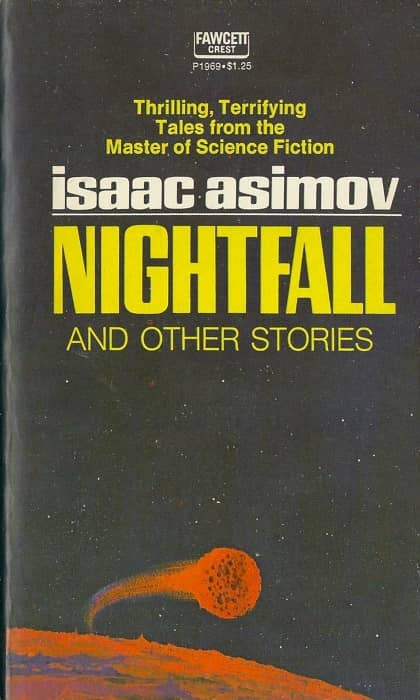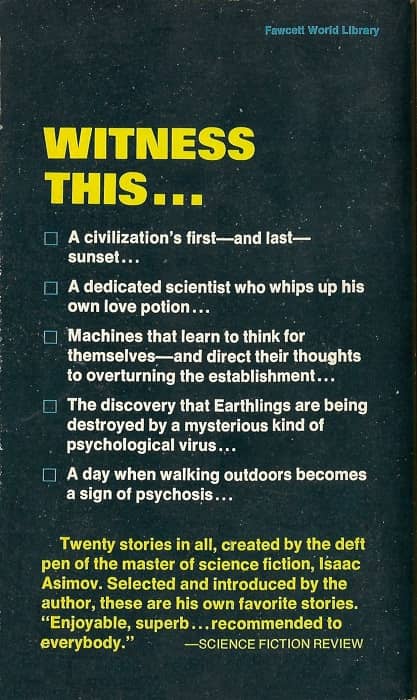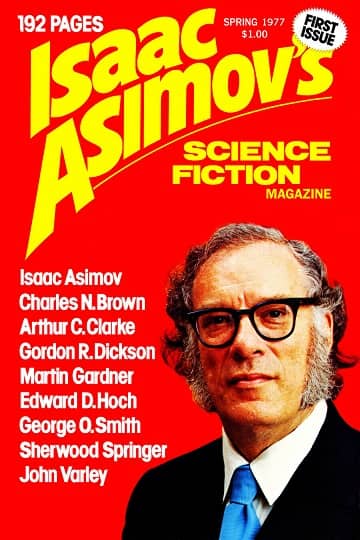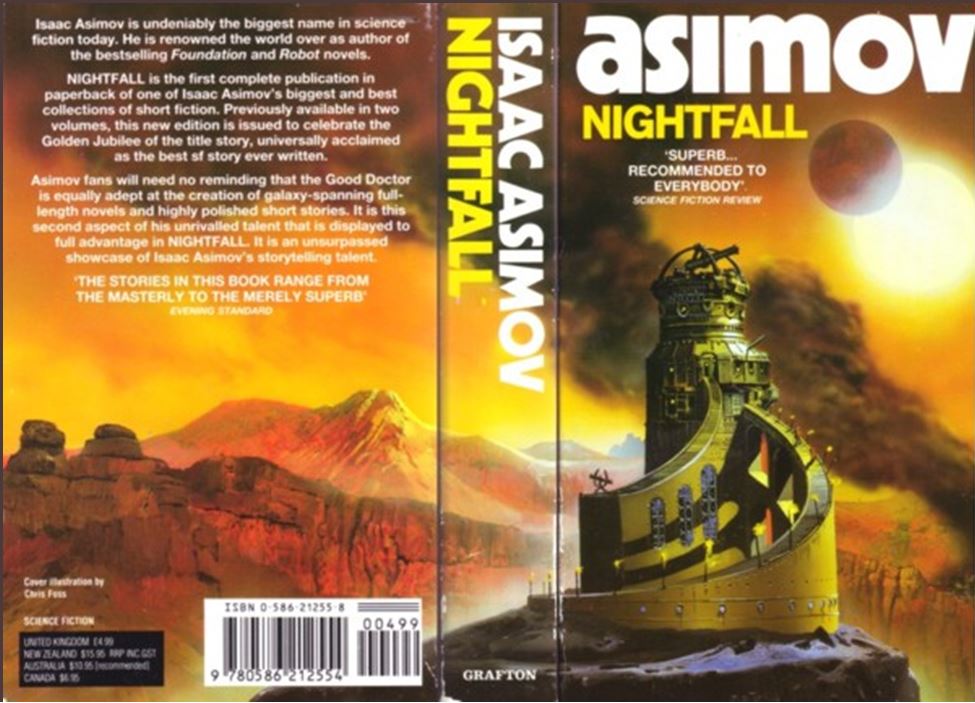Vintage Treasures: Nightfall and Other Stories by Isaac Asimov
 |
 |
Nightfall and Other Stories (Fawcett Crest, 1970). Cover artist unknown.
I’ve been buying small collections recently, and writing about some of the more interesting items here. Two months back I was unpacking a box of 70s paperbacks, and I made a genuinely interesting find: a copy of Nightfall and Other Stories by Isaac Asimov.
Asimov was one of my heroes. There was a time in the 70s and 80s when he was science fiction, the embodiment not just of what was best in modern SF, but its living history. Asimov was one of John W. Campbell’s early discoveries in Astounding, part of that famous group of brilliant writers that shook up the genre and remade it from the ground up. He began his career as a teenage writer for the pulps in the late 30s, and produced some of the most important SF of the 20th Century in his early years, including the cycle of futuristic mysteries starring Susan Calvin that became I, Robot, the decades-long bestseller Foundation and its sequels, and many, many others.
A generous selection of those tales are collected in Nightfall and Other Stories, including the title story “Nightfall,” selected by the Science Fiction Writers of America as the best science fiction story of all time in 1968, when it was included in The Science Fiction Hall of Fame Volume One, 1929-1964. “Nightfall” is the oldest story in the collection, but there are plenty more from Asimov’s most productive period in the magazines, including “Breeds There a Man…?”, the Multivac tale “The Machine That Won the War,” and “Eyes Do More Than See.”
It’s an understatement to say that Nightfall and Other Stories was popular. It was required reading among SF fans, back in the days when kids hung out in cafeterias at lunch and talked about books. Like Dune, Starship Troopers, and The Lord of the Rings, it was simply expected that you were conversant with it, and could keep up with a conversation that referred obliquely to the stories. I’m sure there were a handful of other collections that were accorded similar respect… but I can’t think of any at the moment.
Asimov included introductions to each of the stories in Nightfall — biographical notes, really — in his usual chatty and entertaining style. I’m sure there were a lot of things he could have talked about, but what he did talk about were the small dramas of writing, editing, and selling the stories.
It was a trend he continued with great success a few years later with The Early Asimov (1972), and again in Before the Golden Age (1974). I read all three essentially back-to-back in the summer of 1977, and they left a powerful impression.

Asimov was an impressive guy to begin with. A prodigy, a professor of biochemistry at Boston University with a Ph.D. in chemistry, a respected editor and non-fiction writer. But much of his early biographical writing — virtually all of it, really — was consumed with a much greater ambition. Asimov wanted to be a science fiction writer, and from a very young age he devoted himself to that goal with determination and zeal.
The biographical notes in Before the Golden Age, Nightfall, and especially The Early Asimov all concern themselves with the lofty ambition of entering the world of science fiction as a professional, and the fascinating way he went about it. Worried when an issue of Astounding didn’t show up in the stands when he expected it to, Asimov took the train into Manhattan to the offices of Street & Smith Publications on May 17, 1938, when he was just 18 years old, and met with editor John W. Campbell. That meeting inspired him to finish writing a short story, and he submitted it personally on June 19, 1938. That meeting lasted for more than an hour, and was the first of near-weekly meetings with Campbell for the next decade.
Asimov wrote about this as if it were the most natural thing in the world. More than that, the ease with which he accomplished all the other goals in his life — grad school, getting married, becoming a professor — and the painstaking, painful, and ultimately fruitful tale of becoming a science fiction writer somehow made that profession seem both vastly more challenging and rewarding than any other possible occupation.
Engineer, doctor, astronaut? All noble and honorable professions, naturally. But they all fell short of the heights of achievement that could be achieved as an SF writer, peering staunchly into the future. Asimov brought such a romance to the whole idea that I’m convinced that half the readers of those volumes must have closed them with the steely determination to become SF writers.
I know I sure did. I wrote my first science fiction story at the age of 12, the year I read those books, and others like them. I pounded it out on my parents typewriter and submitted it to — naturally enough — Isaac Asimov’s Science Fiction Magazine in 1977, the year it was founded. “Vital Factor,” masterpiece that it was, was rejected by the editor, George Scithers, with a very kind note. But I kept at it, just as Asimov had done, until my first story was published many years later.
Asimov found that he liked writing about himself just as much as he liked writing stories, and he was an entertaining enough writer to pull it off. Eventually he wrote three long memoirs, In Memory Yet Green: The Autobiography of Isaac Asimov, 1920-1954 (1979), In Joy Still Felt: The Autobiography of Isaac Asimov, 1954-1978 (1980) and I, Asimov (1994).
The seed of all that was in the biographical comments in Nightfall and Other Stories, and those notes still make delightful reading today. So do the stories. Here they are.
Biographical Comments by Isaac Asimov
“Nightfall”(Astounding Science-Fiction, September 1941)
“Green Patches” (Galaxy Science Fiction, November 1950)
“Hostess” (Galaxy Science Fiction, May 1951)
“Breeds There a Man … ?” (Astounding Science Fiction, June 1951)
“C-Chute” (Galaxy Science Fiction, October 1951)
“In a Good Cause—” (New Tales of Space and Time, 1951)
“What If— ” (Fantastic, Summer 1952)
“Sally” (Fantastic, May-June 1953)
“Flies” (The Magazine of Fantasy and Science Fiction, June 1953)
“Nobody Here But—” (Star Science Fiction Stories, 1953)
“It’s Such a Beautiful Day” (Star Science Fiction Stories No. 3, 1955)
“Strikebreaker” (Science Fiction Stories, January 1957)
“Insert Knob A in Hole B” (The Magazine of Fantasy and Science Fiction, December 1957)
“The Up-to-Date Sorcerer” (The Magazine of Fantasy and Science Fiction, July 1958)
“Unto the Fourth Generation” (The Magazine of Fantasy and Science Fiction, April 1959)
“What Is This Thing Called Love?” (Amazing Stories, March 1961)
“The Machine That Won the War” (The Magazine of Fantasy and Science Fiction, October 1961)
“My Son, the Physicist” (The Magazine of Fantasy and Science Fiction, April 1963)
“Eyes Do More Than See” (The Magazine of Fantasy and Science Fiction, April 1965)
“Segregationist” (Abbottempo 4, December 1967)
It’s been many years since I read it, but many of the stories in this collection linger in my memory still.
Nightfall (Grafton UK, 1991). Cover by Chris Foss
It’s been so long, in fact, that I don’t trust myself to comment meaningfully before I spent a lot of time with this book. But you certainly don’t need my take — there’s plenty of modern commentary.
One of my recent favorites is this deeply detailed and thoughtful story-by-story review at Vacuous Wastrel, from 2018. Here’s a small excerpt.
Asimov tends to lead with an unsettling or confusing situation, and follow up with exposition; things like ‘plot’ and ‘characterisation’ take a back seat. He’s also not a great master of prose style; when he gives himself a moment to wax poetical in his descriptions, he’s honestly not bad at it, but that’s not his area of interest, and in general his stories are driven by dialogue…
Where many modern writers seem to be writing as though composing some great, sprawling multi-season drama, Asimov’s stories are more in the vein of an anthology show like The Twilight Zone or Black Mirror (indeed, many of his stories have been adapted for such shows). There’s no time (or frankly interest) in meaty, relationship-based drama, or even for expansive action set pieces. Instead, Asimov’s general modus operandi is to construct a situation and an atmosphere – and most often finish on some mildly unsettling twist….
“Nightfall”
With his iconic “Nightfall,” Asimov begins with a bang – or rather, with a slow but consuming fire… “Nightfall” is a gem. I mean that – it feels like one of those stories that must have just landed in the author’s head one morning, perfectly formed in all its details… The story may not deserve its legendary title as the greatest of all works of science fiction; but it’s a story from 1941 that still (the odd cobwebbed word aside) feels just as relevant, just as fascinating, today, and that’s no mean feat – and it’s a story that still deserves its place in anthologies of the genre.
“Breeds There A Man… ?”
Elwood Ralson, noted atomic engineer, does not want to kill himself. But he may not have a choice – because there are some truths in the universe that man was never meant to know… “Breeds There A Man…?” is one of the best H.P. Lovecraft stories that H.P. Lovecraft never wrote… an uneasy and interesting story that offers another side of Asimov.
“C-Chute”
Five men remain on a captured starship, waiting for imprisonment on the alien homeworld. Each has their own desperate reason to escape and to return home to Earth – but can any reason be powerful enough when only an act of heroism can save the day?
Another alien star wars story, of the kind popular in the era, but that Asimov never wrote. The real surprise, however, is how he goes about writing it…. he decided to take on this genre by… minimising the action, magnifying the claustrophobia, and concentrating on character and description!… the strength of the story lies, strangely, in its descriptive passages, particularly in the second half, where Asimov takes the tropes of these spaceship-dramas and writes a scene we’ve all seen a dozen times in SF shows on TV, but subjects it to the cold light (or darkness) of physics, and somehow makes the result more beautiful and intimidating in the process.
“What is this Thing Called Love?”
Hapless aliens abduct two humans and attempt to observe their mating rituals – their knowledge of which derives entirely from 1930s erotic science fiction stories about aliens abducting humans and observing their mating rituals… First published as “Playboy and the Slime God”, this is a complicated, multi-tiered parody…
Weirdly, it works. Sex and humour are two areas of weakness for Asimov, but somehow, putting both of them together here works fantastically – probably because for once he lets the humour of his scenario speak for itself, and limits himself to a deadpan flippancy that he’s actually pretty good at (and because any cliché moments in dialogue and characterisation are justifiable through appeal to parody). The result is certainly not a surprising work – you can work out most of the jokes yourself from the description – but it’s a fun one, that takes a timeless scenario and does very well with it. I couldn’t help noticing the fore-echoes here of The Simpsons – if Kang and Kodos abducted Marge and Homer to ‘observe’ them, the result could well be something like this.
Nightfall and Other Stories was published by Fawcett Crest in November 1970. It is 350 pages, priced at $1.25. The cover artist is unknown.
See all our recent Vintage Treasures here.

Absolutely, John! You don’t impress me by being a prof and writing a load of non-fiction books (hardly an onerous task, as you’re writing about stuff that’s true) – making stuff up, though? Not so easy.
Like you, I read a lot of Asimov short stories as a teenager. I remember the introductions being pretty funny – like how some editor included the big reveal for his story ‘Exile to Hell’ as part of the intro, so it had ‘all the impact of a strand of wet spaghetti’. Funnily, I don’t remember anything about ‘Nightfall’, even though it was the title story. The story from this collection that really sticks in my mind was ‘Hostess’ which I must check out again. It was pretty good.
I agree completely, Aonghus.
Well, except for that bit about ‘Hostess,’ which I don’t remember at all! I’ll have to re-read it this weekend and see if it jogs any memory cells. In any case, I’m looking forward to it.
The other collection that, for me, stands out as essential is Heinlein’s THE GREEN HILLS OF EARTH.
The very copy I bought in middle school and that still sits on my shelf. If Asimov were as great a novelist as he was a short story writer, he’d be the greatest SF writer ever. As it was, though…
> The other collection that, for me, stands out as essential is Heinlein’s THE GREEN HILLS OF EARTH.
RK,
I was thinking of mentioning Heinlien’s THE PAST THROUGH TOMORROW. But I’ve never been able to finish that book. THE GREEN HILLS OF EARTH is a much better choice!
> If Asimov were as great a novelist as he was a short story writer, he’d be the greatest SF writer ever.
I have to agree with you there, Thomas (especially when you consider that the FOUNDATION novels were all originally published as stories.)
I, Robot, the Foundation novels, and many of Asimov’s collections are essential reading if you want to understand 20th Century SF. But his other novels, not so much. (I do set aside his Elijah Baley / R. Daneel Olivaw novels, The Caves of Steel and The Naked Sun, since I haven’t read them and they’re frequency cited by folks I trust as among his best.)
Thank you for the shout-out, and the kind words!
One thing I didn’t say in my review, but that I think complements your comments here about the ubiquity of this book for young SF fans in the 70s: I didn’t buy this book. The copy I read is my dad’s old copy of it, from the 70s. He’s never been a big reader (not of fiction, anyway), but he was a big Asimov fan. He read me some stories when I was young and gave me his copy of this anthology when I was 9 or 10…
Anyway, it’s an interesting anthology – even the bad stories have interesting aspects – but I think it’s a bit unfortunate that for many people it is THE Asimov anthology. There’s only one outright classic Asimov story here, and a lot of the stories are very… well, un-Asimovian.
It’s annoying, because you somebody could print a really brilliant anthology of around, say, 12 or 15 of Asimov’s best stories… but nobody has. It’s all in semi-random anthologies of a couple of good stories and a bunch of bad ones, or else in giant anthologies too big for a casual reader to attempt. Much of this is Asimov’s fault – he limited publication of ‘Nightfall’, the story, and also tended to exclude his robots stories (and Foundation) from non-robots anthologies, and had bizarre affection for some of his worst stories (and ‘comic’ poetry…) so there was never a really good ‘best of’ anthology. And now, I guess, there’s not the demand for it anymore… but one day, hopefully, some publisher will do a really great ‘classic stories’ edition…
Wastrel,
Thanks for the comment! I think you’re bang on with the suggestion that there isn’t really a BEST OF ASIMOV. There was a 1973 paperback from Sphere with that title (reprinted in the US by Fawcett Crest in 1974), but I don’t think it really came close.
It didn’t include any of his classic Robot stories, or Foundation novellas, or “The Ugly Little Boy.” But it does include “The Last Question,” and one Elijah Baley / R. Daneel Olivaw story, “Mirror Image.”
Here’s the complete Table of Contents. I’d be interested to hear what you think:
Bibliography by Gerald Bishop
Introduction by Isaac Asimov
“Marooned Off Vesta” (1939)
“Nightfall” (1941
“The C-Chute” (1951)
“The Martian Way” (1952)
“The Deep” (1952)
“The Fun They Had” (1951)
“The Last Question” (1956)
“The Dead Past” (1956)
“The Dying Night” (1956)
“Anniversary” (1959)
“The Billiard Ball” (1967)
“Mirror Image” (1972)
I still have my old Pan Paperbacks (the UK version was in two volumes), and was happy to see that they also have the linking commentaries. Must return to those again. Thanks for pointing out the books that had Isaac’s biographical commentaries, and their order reading them in succession should be a rewarding exercise.
I remember reading the UK only paperback, THROUGH A GLASS, CLEARLY. I still have it. It was excellent, and a good dress rehearsal for NIGHTFALL AND OTHER STORIES, which contained three of its four stories.
I have also been frustrated by the lack of a true Best of Asimov. But I reckon that if you have the Foundation Trilogy, The Complete Robot, and the Complete Stories, Volumes 1 and 2 (this time definitely the US editions), you’ve come as close as you can in just four books.